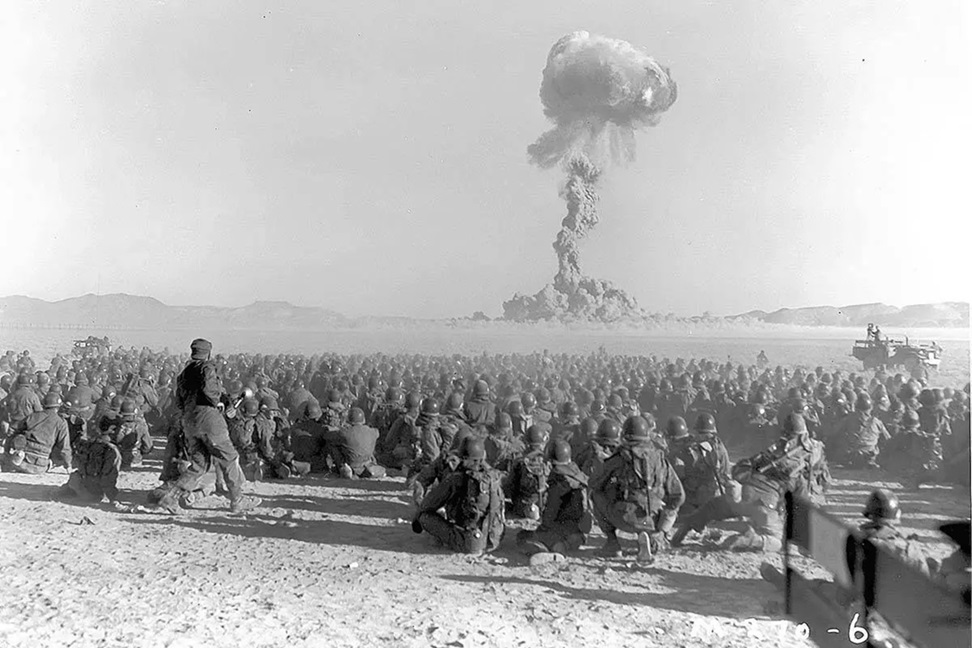This article explores the central role of J. Robert Oppenheimer in the development of the Manhattan Project and its profound impact on international relations. Tracing the historical context of the project launched in 1939, we examine Oppenheimer’s intellectual leadership, his role in the successful Trinity Test in 1945, and the immediate implications for World War II and the start of the Cold War. Delving into the postwar debates, we analyze Oppenheimer’s advocacy for international nuclear arms control and the controversies that followed. Oppenheimer’s scientific legacy still resonates today, sparking ethical and political questions about nuclear technology. By examining scientific implications, current ethical dilemmas, and contemporary references, this article provides a comprehensive retrospective while interrogating current challenges related to global responsibility in an ever-changing technological context.
Historical Reminder
J. Robert Oppenheimer, a prominent American physicist, occupies a central place in history as the scientific director of the Manhattan Project during World War II. This project, launched in response to concerns about a potential German advance in the nuclear field, resulted in the creation of the first atomic bomb, radically transforming the global geopolitical landscape.
In the context of World War II, rapid advances in nuclear research created urgency for the Allies. Oppenheimer, already renowned for his work in theoretical physics, was chosen to lead this ambitious project, bringing together a team of eminent scientists.
Oppenheimer’s Leadership: Appointed as scientific director in 1942, Oppenheimer was much more than just a project manager. His intellectual leadership was essential in overcoming the complex challenges of nuclear fission, bringing together brilliant minds to work collaboratively. Development of the Atomic Bomb: Intensive work culminated in monumental success with the Trinity nuclear test in July 1945 This scientific achievement was the culmination of the strenuous efforts of Oppenheimer and his team, but it also ushered in a new era with the creation of a weapon of unprecedented power. The atomic bomb, used at Hiroshima and Nagasaki, immediately ended the war, but it also redefined the balance of power. The United States, now in possession of this powerful weapon, emerged as a superpower, marking the start of the Cold War and thus transforming international relations in profound and lasting ways
Manhattan Project
The Manhattan Project, initiated in 1939 in response to Nazi Germany’s probable advances in the nuclear field, represents a major milestone in contemporary history, with J. Robert Oppenheimer as the emblematic figure of this scientific enterprise with global repercussions.
Oppenheimer, a renowned theoretical physicist, assumed the role of scientific director of the project, assembling an exceptional team of scientists, including Enrico Fermi and Richard Feynman, to realize the ambitious goal of developing a nuclear weapon before the Axis forces. This enterprise, framed by the context of the Second World War, was imperative to guarantee that the Allies had a decisive weapon to end the conflict.
The culmination of these efforts was the historic Trinity test in July 1945 in the New Mexico desert, marking the first successful detonation of an atomic bomb. This scientific feat shook the very foundations of international relations of the time. The subsequent use of this devastating weapon at Hiroshima and Nagasaki not only hastened the end of the war, it also ushered in a new era characterized by nuclear power and deterrence. The impact of the Manhattan Project on international relations cannot be underestimated. The United States’ possession of this revolutionary technology shaped the new balance of power globally, marking the start of the Cold War. The capacity for mass destruction offered by nuclear weapons has established a climate of deterrence which has redefined diplomatic and military strategies, thus transforming the geopolitical landscape in a profound and lasting way.
Modern World
Essential historical references include the contemporary writings of Oppenheimer himself, such as his letters and speeches, as well as official documents from the Manhattan Project. The works of Richard Rhodes, notably “The Making of the Atomic Bomb,” offer an in-depth analysis of this crucial period. The memoirs of other scientists involved, such as Enrico Fermi, also provide essential insights into the internal dynamics of the project. The use of the atomic bombs on Hiroshima and Nagasaki was a decisive turning point in world history, shaping not only the end of World War II, but also laying the foundations for the Cold War, an era characterized by sustained political and military tensions between the United States and the Soviet Union.
When the United States dropped the atomic bombs on Hiroshima on August 6, 1945, and Nagasaki on August 9, 1945, respectively, the ensuing devastation caused a dramatic acceleration of the Japanese surrender, thus ending the global conflict.
However, this unprecedented use of nuclear power also ushered in a new era in international relations.
The balance of power between the United States and the Soviet Union shifted radically. The United States now possessed a weapon of incredible power, conferring strategic superiority, while the Soviet Union, worried about this advantage, quickly embarked on its own nuclear programs. This nuclear arms race created a balance of terror, where the threat of mutual destruction engendered precarious stability, thereby defining the dynamics of international relations. The Cold War, which emerged in the years following World War II , has been characterized by ideological rivalries, military alliances and indirect confrontations across the world. Nuclear deterrence strategies became the central pivot of this period, with doctrines such as Mutually Assured Destruction (MAD) emerging, emphasizing that any nuclear attack would trigger a similar, all-out response.
Events such as the Cuban Missile Crisis of 1962 poignantly illustrated the palpable tension between nuclear superpowers and the risks inherent in possessing such weapons. The doctrine of nuclear deterrence has become an essential element of international relations, influencing foreign policies and diplomatic negotiations.
The writings of military strategists such as Herman Kahn and political speeches of the period attest to the crucial importance of the nuclear threat in shaping politics and international relations. Treaties such as the Nuclear Non-Proliferation Treaty (NPT) of 1968 reflect global efforts to contain the proliferation of nuclear weapons. The post-war period saw J. Robert Oppenheimer actively advocate for international control of nuclear weapons. nuclear weapons, reflecting an acute awareness of the intrinsic risks associated with this devastating technology. His central role in the Manhattan Project, while carrying a monumental scientific breakthrough, also cast a controversial shadow over his commitment to global security. Oppenheimer, aware of the moral and strategic implications of nuclear weapons, argued for an international control system aimed at preventing uncontrolled proliferation and maintaining a stable balance between the great powers. His speeches and writings of the period reflect his commitment to scientific responsibility in the emerging nuclear age. However, this altruistic stance placed him at the heart of controversies during the era of McCarthyism, a period of anti-communist witch hunts in the United States in the 1950s. His calls for international control and his commitment to ideas considered progressive raised suspicions about his political affiliations.
Accusations of communist sympathies led to a security investigation in 1954, conducted by the Un-American Activities Commission. Although Oppenheimer was cleared
From these accusations, his authority and access to classified information was revoked, marking a period of professional decline. The implications of this post-war period for Oppenheimer speak volumes about the ideological and political tensions of the time. His advocacy for nuclear arms control can be seen as a visionary attempt to forestall future risks, while the consequences of his involvement in McCarthyism underscore the challenges facing even the most eminent scientific minds in a polarized political climate.
Reference works from this period include archival materials from the McCarthy hearings, Oppenheimer’s speeches on nuclear arms control, and historical analysis by scholars such as Kai Bird and Martin J. Sherwin, authors of the biography ” American Prometheus: The Triumph and Tragedy of J. Robert Oppenheimer.”
Modern Heritage
The compelling legacy of J. Robert Oppenheimer resonates intensely across the contemporary landscape, marking an indelible chapter in international relations and sparking inherently complex debates, rich with considerable ethical and political ramifications. The scientific advances he initiated, primarily through the Manhattan Project, continue to weave invisible threads that profoundly influence global dynamics, revealing fundamental questions about the delicate intertwining between technological progress and global responsibility.
J. Robert Oppenheimer’s contributions to nuclear science have sculpted the global landscape, giving nuclear technology a dual status as both a generator of power and a source of concern. The scientific advances catalyzed by Oppenheimer during the Manhattan Project charted major technological paths, redefining how society approaches energy power and medical advancements. However, this scientific revolution also introduced moral dilemmas, raising substantial concerns about the proliferation of nuclear weapons and the implications of the nuclear arms race.
Oppenheimer’s legacy resonates in contemporary debates, injecting crucial ethical and political issues into the global dialogue. Ethical questions surrounding the use of nuclear weapons, nuclear research and global governance persist, crystallizing tensions between the quest for scientific progress and the need to maintain global stability. Initiatives to prevent the proliferation of nuclear weapons, non-proliferation negotiations, and disarmament efforts reflect the current implications of this scientific legacy.
The contemporary echo of Oppenheimer’s legacy highlights the critical need to skillfully navigate the complex marriage between technological advancement and global responsibility. As science continues its rise, global decision-makers face
to the arduous task of channeling technological advantages while minimizing associated risks. International policymaking, scientific transparency and the establishment of ethical standards remain at the heart of efforts to ensure that the impact of technological advances is managed responsibly and ethically.
The work of contemporary scholars, such as David Holloway and Pervez Hoodbhoy, provides critical perspectives on current issues related to nuclear security and global governance. Reports from international organizations, such as the International Atomic Energy Agency (IAEA), are crucial references to inform debates on nuclear security.
Title image courtesy: https://klublr.com/
Disclaimer: The views and opinions expressed by the author do not necessarily reflect the views of the Government of India and Defence Research and Studies
References:
“American Prometheus: The Triumph and Tragedy of J. Robert Oppenheimer” by Kai Bird and Martin J. Sherwin – This biography of elves into Oppenheimer’s life, providing valuable insights into his role in the Manhattan Project and the subsequent challenges he faced.
“The Making of the Atomic Bomb” by Richard Rhodes – A comprehensive historical account that explores the scientific, political, and ethical dimensions of the development of atomic weapons.
“Now It Can Be Told: The Story of the Manhattan Project” by General Leslie R. Groves – Written by the military leader of the Manhattan Project, this book provides an insider’s perspective on the project’s management and challenges.
“Dark Sun: The Making of the Hydrogen Bomb” by Richard Rhodes – Expanding beyond the atomic bomb, this book covers the development of the hydrogen bomb and its implications for international relations.
“Oppenheimer: Portrait of an Enigma” by Jeremy Bernstein – A detailed exploration of Oppenheimer’s character and contributions, offering nuanced insights into his complex personality.
“The Seventh Decade: The New Shape of Nuclear Danger” by Jonathan Schell – This work examines the evolution of nuclear weapons and their continuing impact on global security, making connections to the Cold War and beyond.
“Command and Control: Nuclear Weapons, the Damascus Accident, and the Illusion of Safety” by Eric Schlosser – Focusing on nuclear weapons safety, this book discusses incidents and accidents that highlight the risks associated with these powerful weapons.
“The Cold War: A New History” by John Lewis Gaddis – Providing a broader context to the Cold War, this book helps understand the geopolitical landscape that emerged after World War II.
“On Nuclear Terrorism” by Michael Levi – This book explores the contemporary challenges and threats posed by nuclear terrorism, drawing connections to historical events.
“Nuclear Weapons and Foreign Policy” by Henry A. Kissinger – Written by a prominent figure in international relations, this work discusses the role of nuclear weapons in shaping foreign policy during the Cold War.
“Brighter than a Thousand Suns: A Personal History of the Atomic Scientists” by Robert Jungk – This book provides a personal history of the atomic scientists involved in the development of nuclear weapons, offering insights into their motivations and dilemmas.
“The Making of the Atomic Age” by Alain Porte – A comprehensive exploration of the scientific, political, and societal aspects of the atomic age, shedding light on the broader implications of nuclear technology.
“The Ruin of J. Robert Oppenheimer and the Birth of the Modern Arms Race” by Priscilla J. McMillan – This work delves into the post-Manhattan Project period, focusing on Oppenheimer’s life, his advocacy for arms control, and the consequences of his political struggles.
“Arsenals of Folly: The Making of the Nuclear Arms Race” by Richard Rhodes – Rhodes examines the nuclear arms race in the context of the Cold War, providing a critical analysis of the decisions and actions that shaped this era.
“The Manhattan Project: The Birth of the Atomic Bomb in the Words of Its Creators, Eyewitnesses, and Historians” edited by Cynthia C. Kelly – A compilation of firsthand accounts and historical analyses, offering a multifaceted perspective on the Manhattan Project.
“Secrecy and the State: US Nuclear Proliferation Policy” by Maria Rost Rublee – This academic work explores the U.S. nuclear proliferation policy and its implications for international relations.





